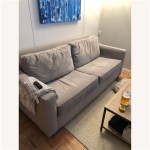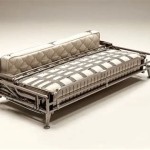Fixing Loose Sofa Legs: A Comprehensive Guide
A wobbly sofa can be a frustrating and potentially dangerous problem. Loose sofa legs can lead to instability, making the sofa prone to tipping over, especially if children or pets are around. Fortunately, fixing loose sofa legs is often a straightforward task that can be accomplished with the right tools and techniques.
Understanding the Cause of Loose Sofa Legs
Before attempting any repairs, it's essential to understand the cause of the loose legs. There are several common reasons why sofa legs might become loose:
- Worn-out fasteners: Over time, screws or bolts holding the legs in place can become stripped or loosen due to wear and tear.
- Damaged wood: The wood connecting the legs to the sofa frame can become cracked or weakened, especially if the sofa is frequently moved or subjected to heavy loads.
- Improper assembly: If the sofa was not assembled correctly in the first place, the legs may not be securely attached.
- Insufficient support: The sofa legs themselves might be weak or not adequately sized for the weight of the sofa, causing them to bend or break.
Fixing Loose Sofa Legs with Screws or Bolts
If the cause of the looseness is worn-out screws or bolts, you can usually tighten them back in place using a screwdriver or wrench. However, before doing so, ensure the screws or bolts are not stripped. If they are, it's best to replace them with new ones:
- Locate the screws or bolts: Examine the underside of the sofa to find the screws or bolts holding the legs to the frame.
- Tighten the screws or bolts: Using a screwdriver or wrench, tighten the screws or bolts securely. Avoid overtightening, as this could damage the wood.
- Replace stripped screws or bolts: If the screws or bolts are stripped, remove them and replace them with new ones of the same size and thread type.
- Test the stability: Once the screws or bolts are tightened or replaced, shake the sofa gently to ensure the legs are secure.
Repairing Damaged Wood
If the wood connecting the legs to the sofa frame is damaged, you'll need to repair it before reattaching the legs. This might involve:
- Cleaning the damaged area: Remove any loose wood particles or debris from the damaged area.
- Adding wood filler: Apply wood filler to fill any cracks or gaps in the wood. Allow it to dry completely before sanding it smooth.
- Reinforcing the wood: If the wood is severely damaged, you might need to reinforce it with wood glue or epoxy. Apply the adhesive to the damaged area and clamp it in place until it sets completely.
- Reattaching the legs: Once the wood is repaired, you can reattach the legs using screws or bolts.
Replacing Loose Sofa Legs
If the legs themselves are damaged or insufficiently sized for the sofa, they may need to be replaced. This process can be more complex than simply tightening screws or bolts. Here's a general approach:
- Locate the leg attachment points: Examine the underside of the sofa to identify where the legs are attached to the frame.
- Remove the old legs: Unscrew or unbolt the old legs from the sofa frame. Note the size, shape, and type of fasteners used.
- Select new legs: Choose replacement legs that are compatible with the sofa's style and appropriate for its weight.
- Attach the new legs: Align the new legs with the attachment points and secure them using the same type of fasteners as the original legs.
It's crucial to choose legs that are compatible with the sofa's frame and weight. Avoid using too-small legs, which can cause the sofa to become unstable. You may also want to consult a furniture repair specialist for more complex leg replacement procedures.
Preventing Future Looseness
To minimize the chances of sofa legs becoming loose in the future, consider these preventative measures:
- Regularly inspect the sofa: Periodically check the sofa's legs and fasteners for signs of wear or looseness.
- Use a furniture glide: Place furniture glides underneath the sofa legs to protect the floor and prevent scratches. These glides also help distribute weight evenly, reducing stress on the legs.
- Avoid overloading the sofa: Be mindful of the weight placed on the sofa, as overloading it can strain the legs and lead to looseness.
- Move the sofa carefully: When moving the sofa, lift it rather than dragging it across the floor to minimize stress on the legs and fasteners.
By following these tips, you can keep your sofa stable and prevent future problems with loose legs. Remember, if you're unsure about any part of the repair process, it's best to consult with a professional furniture repair specialist.

How To Fix A Loose Sofa Leg

How To Fix A Loose Sofa Leg

How To Fix A Loose Sofa Leg

Repairing Furniture And Sofa Legs

How To Fix A Loose Sofa Leg

How To Fix A Loose Sofa Leg

How To Fix A Loose Sofa Leg

Sofa Leg Or Chair Repair Furniture Restoration Upholstery How To

How To Change Out Hanger Bolts In Furniture Legs

Furniture Leg Repair Using Toothpicks








